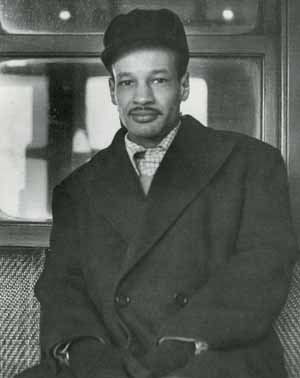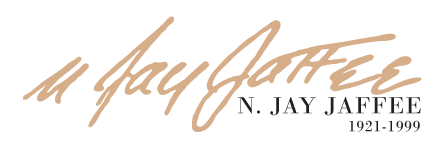
Felrath Hines, New Lots Avenue IRT, Brooklyn, 1947. Photograph by N. Jay Jaffee. Featured in the 1995 exhibit "Felrath Hines" at the Indianapolis Museum of Art, it is part of the National Portrait Gallery collection.
The artist remembers his lifelong friend, painter and conservator
Felrath Hines.
The lives of many young men were disrupted by World War II. When the war ended, many veterans looked for work and careers which they thought would be more appealing than their earlier occupations. At the suggestion of several career analysts, I was encouraged to enter the art field, although I had worked in the printing industry for several years before the war.
In 1947, I was offered an opportunity to decorate chinaware. The idea interested me, even though painting roses was not considered, in some circles, high art. However, it turned out to have at least one compensation—Felrath Hines.
After about a year of experience, I found myself working in a factory applying gold bands around the edges of dinnerware. Sitting alongside of me, on the very first day, was Felrath. We soon developed a repartee that included humorous comments about our imposing supervisor and the hopeless occupation we were engaged in. To our delight, we also discovered a similar intense interest in jazz and classical music. By the end of the day, we had become friends. That friendship was to last a lifetime.
Felrath had recently arrived in New York City, after working on the railroads out of Chicago. Several weeks after our initial meeting, I invited him for dinner at my house. (Years later, I learned that I was the first person who befriended him in New York.) I lived in what was then a somewhat rural area called East New York, bordering on the marshlands of Jamaica Bay and Queens. From downtown Brooklyn, where we worked, we took the New Lots Avenue IRT (Interboro Rapid Transit) subway, which became elevated as we neared the last stop. At that moment, I took advantage of the available light and made one exposure of Fel. (When I photographed people, artificial light never appealed to me. The natural possibilities fascinated me, as they still do today.)
There were subsequent dinners and visits after we both left that Brooklyn factory. Fel was occupied with his painting and began working for Kulicke, a well-known framer. He was also developing skills and techniques that he would use in his career as an art conservator. I continuing photographing and did other work to help pay my rent. When Fel would visit New York, after moving to Silver Spring, we would greet each other like long-lost brothers, even though we kept in touch by telephone between visits.
Strong-willed and independent, Felrath insisted on maintaining a certain way of life that had meaning and direction. Sometimes, early on, we shared a sense of disappointment about our lack of recognition with the art community, but Fel always felt that work came first; success, while important for the artist, was only a by-product, not the reward or motivation for creativity. His skill and dedication enabled him to become a renowned conservator at two of our nation’s most prestigious art institutions, the National Portrait Gallery and the Hirschhorn Museum. His paintings also express his unique talent, and will no doubt be regarded as an important contribution to art history.
Felrath Hines was a noble and inspiring person, and a good friend. Whenever I see the portrait I made of Fel on the train that day, it reminds me of how he lived and worked—with dignity, strength, and perseverance.
© 1994 N. Jay Jaffee. All rights reserved.
